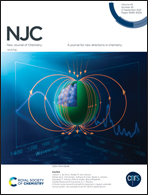A novel and cost effective isatin based Schiff base fluorophore: a highly efficient “turn-off” fluorescence sensor for the selective detection of cysteine in an aqueous medium†
Abstract
A novel Schiff base ligand, 3-(2-amino-4,5-dimethyl-phenylimino)-5-phenyl-1,3-dihydro-indol-2-one (MPD 5MI), was developed and characterized using spectroscopic methods, including UV-visible, infrared, 1H-NMR, 13C-NMR, and mass spectrometry. The essential fluorescence properties, such as the quantum yield, Stokes shift, and average lifetime value, of the newly synthesized Schiff base-derived fluorophore were investigated. Inspired by the excellent fluorescence properties achieved, a turn-off fluorescence sensor was conceived for the detection of cysteine, in which the fluorescence intensity of the probe was quenched upon the addition of cysteine via a combined static and dynamic quenching mechanism. It also gives a low detection limit of 3.97 × 10−11 Mand a linear range of 2 × 10−7 M to 5 × 10−7 M under the optimized conditions. It also demonstrates the selective detection of cysteine even with the existence of biologically relevant amino acids. To gain more information about the structure–property relationship of the system, HOMO–LUMO energy levels were calculated using experimental and theoretical studies (DFT calculations), which correlated with good agreement. Furthermore, the practical sensing abilities of the probe were investigated in real samples, showing satisfactory results.



 Please wait while we load your content...
Please wait while we load your content...